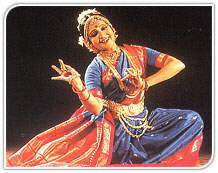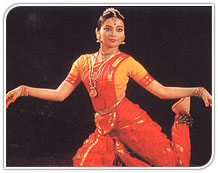Dances of India: Bharatnatyam
 Bharat
Natyam, one of the oldest Indian Classical dance forms is in essence a
dedicatory dance. This was performed by Devadasis in the temples,
primarily in Tamil Nadu and to a lesser extent in Andhra Pradesh and
Karnataka.
Bharat
Natyam, one of the oldest Indian Classical dance forms is in essence a
dedicatory dance. This was performed by Devadasis in the temples,
primarily in Tamil Nadu and to a lesser extent in Andhra Pradesh and
Karnataka.
Bharat Natyam is compounded from 'bha' for bhava or
emotional projection, 'ra' for raga or melody and 'ta' for tala or rhythm.
Natyam means the art of dance.
The Sangam Age from 500 B.C. to
500 A.D marks the evolution of this dance form.
The early part
of the present century saw the resurgence of this dance form. The key
posture of this dance form requires the upper part of the body to be
erect, the legs bent halfway down with the knees spread out, and the feet
positioned like a half-open fan.
Practically every member of the
body has its distinct movement. It is intended to be danced solo, but
nowadays group work is equally popular.
 The
songs used are composed from the poetic literature of Tamil, Telugu,
Sanskrit and to some extent Kannada.
The
songs used are composed from the poetic literature of Tamil, Telugu,
Sanskrit and to some extent Kannada.
The accompanying music is
in pure Carnatic style.
Experimentation is often the norm rather
than an exception and today the music draws from diverse natural sources.
Today, Bharat Natyam is not a dance style but a dance technique
- a system, from which came out the other classical dance forms of Mohini
Attam and Kuchipudi.
 Bharat
Natyam, one of the oldest Indian Classical dance forms is in essence a
dedicatory dance. This was performed by Devadasis in the temples,
primarily in Tamil Nadu and to a lesser extent in Andhra Pradesh and
Karnataka.
Bharat
Natyam, one of the oldest Indian Classical dance forms is in essence a
dedicatory dance. This was performed by Devadasis in the temples,
primarily in Tamil Nadu and to a lesser extent in Andhra Pradesh and
Karnataka.  The
songs used are composed from the poetic literature of Tamil, Telugu,
Sanskrit and to some extent Kannada.
The
songs used are composed from the poetic literature of Tamil, Telugu,
Sanskrit and to some extent Kannada.